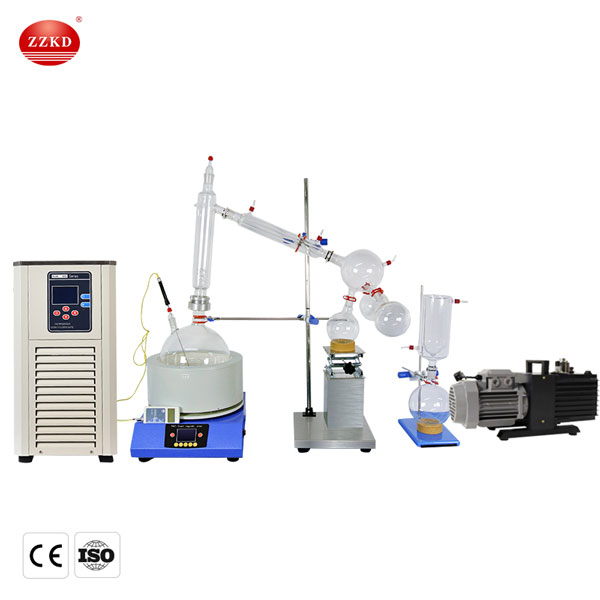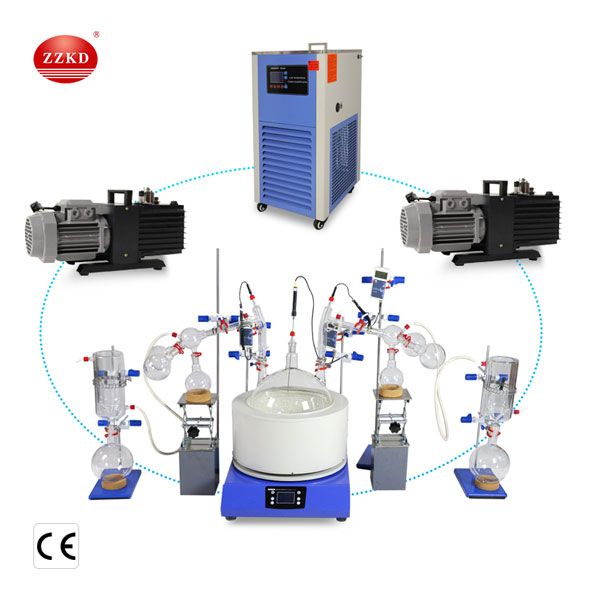News
Application Of Short-Path Distillation In Oleochemical Industry
What is distillation equipment?
Simple short path distillation system can not only improve the quality and yield, but also effectively prevent the decomposition of heat-sensitive products under a general range of process conditions. When developing a new product, the basic goal at the laboratory stage is optimum synthesis and optimum quality. In industrial production, however, emphasis is placed on yield, economy and safe operation. The intermediate stage between the transition from laboratory glass equipment to large-scale production plants is the use of pilot production plants.

Application of short distillation apparatus in oleochemical industry:
There are many high-molecular-weight, high-boiling, heat-sensitive materials in oleochemistry and oil-related industries, such as monoglycerides, diglycerides, polyglycerols, polyglycerol esters, phospholipids, vitamin E, vitamin A, sterols, fatty alcohols, etc. , they have been incapable of concentrating and purifying them in the past, and they have been satisfactorily solved by industrial short path distillation.

1. Monoglyceride distillation and purification
Monoglycerides are glycerol monofatty acid esters. Monoglycerides are used as margarine emulsifiers, bread and pastry shortening agents, flour modifiers, foaming agents, shape retention agents, etc. in the food industry. Monoglycerides also have many uses in the cosmetic industry. There are three methods for preparing monoglycerides, such as enzymatic decomposition of oils and fats, transesterification of glycerol and oils, and esterification of glycerol and fatty acids.
Generally, the monoglyceride content of the reaction product is 40% to 60%, and some are only 35% to 45%. The boiling point of monoglyceride is much higher than that of corresponding lipoic acid, such as stearic acid boiling point under 133Pa pressure is 183℃, and glycerol monostearic acid is 223℃ under 133Pa, and monoglyceride is 40℃ higher. At the same time, monoglyceride is a heat-sensitive material, which is difficult to purify by vacuum distillation. The short-path distillation can separate the monoglyceride from the diglyceride and other substances such as glycerol in the reactant. The purity of the distilled monoglyceride can reach more than 90% and the yield can reach 80%. High-purity monoglyceride has better flavor than reaction monoglyceride with low content, and has high emulsifying performance, and the use of naan can be reduced to 10%~20%.
2. Recovery of polyglycerol from glycerin residue
Glycerol is a by-product of oil hydrolysis and the soap making industry. In the distillation and refining of crude glycerin, about 2.5% of the glycerin is lost in the stump, and an industrial company with an annual output of 4500t of glycerol loses more than 100t of glycerin products in the stump. The residual foot mainly contains polyglycerol in addition to less glycerin. Polyglycerol is the starting material of important food additive polyglycerol. Glycerol is a heat-sensitive high-boiling substance. The normal pressure boiling point of glycerin is as high as 290 °C (decomposition). Partial polymerization and decomposition occur at 204 °C, and the boiling point of polyglycerol is even higher.
However, the glycerol distillation residue containing 8.1% of glycerol and 62.6% of diglycerol was distilled through short-path distillation under 50~120Pa vacuum, respectively, at 150°C and 210°C to distill out 85.5% glycerol phase with a content of 73.4%. % of polyglycerol.
3. Distillation and concentration of sterols
Sterols are an important new drug source for the steroid drug industry, and also have important uses in medicine, cosmetics and artificial feed for silkworms. Animal and vegetable oils generally contain sterols, and the refining of animal and vegetable oils is an important source of sterols. In the distillation process of producing fatty acids from fats and oils in my country, most of the sterols are destroyed by pyrolysis and oxidative degradation because the materials are subjected to long-term high temperature in the gap distillation still. Such as cotton oil soapstock hydrolyzed crude mixed acid (black fatty acid) containing 1.35% ~ 1.58% sterol, after kettle short distillation apparatus, the residual sterol contains only 0.1% ~ 0.8% sterol, and all the balls are destroyed.
The acidified oil produced by Weisuo is recovered, and its hydrolyzed crude acid contains 4.1% sterol, and the sterol content of the black foot in the kettle-type high temperature and long-term distillation is only 1.93%. During the short distillation apparatus process, 89.2% of the sterol in the raw material was When thermal damage occurs, only about half of the steroids can be retained in falling film distillation.Sterols can be substantially undamaged using short path distillation. Through short-path distillation, the sterol in the bottom of the oil can be concentrated by 4 to 6 times. For example, the acidified oil recovered from oryzanol is hydrolyzed and short distillation apparatus, and the sterol in the distilled blackfoot is increased to 20%~27%.
4. Vitamin E distillation concentration and purification
Deodorized distillates from the refining of soybean oil, rice bran oil, and some other edible oils are rich in Vz. Using it as a raw material, after pretreatment, a secondary short-path distillation device with a production capacity of 80kg/m h is used to obtain a content of 60%~70% paste V, the recovery rate can be as high as 80%. If further purified, Vz products with purity close to 100% can also be obtained.
For the synthesis of vitamin E, the crude product with a content of 91.9% can be purified by short-range distillation. The total distillation rate can reach 90%~92% to the shoulder product with a content of more than 96%.
5. Concentration of Vitamin A
The separation of vitamin A from cod liver oil can be achieved by short distillation apparatus, with a concentration of 9.6 times and a yield of 70%. Good equipment Va yield can be increased to 87%. During distillation and concentration, only about 5% is destroyed.
6.Other oleochemical applications
At present, short-path distillation is also increasingly showing its advantages in the oleochemical industry fields of fatty acids and their derivatives, fatty acid dimers, vegetable oils, tall oils, epoxidized oils, fatty alcohols, trichomonyl esters, antioxidants, etc. The advantages of high quality, high efficiency and economy are widely used.
Send Us Message
Your message was sent successfully.
Sorry!Something Went Wrong.
